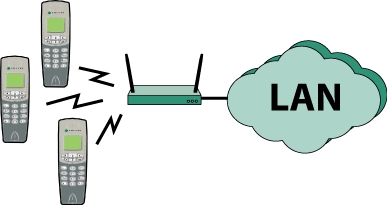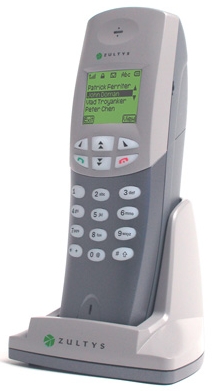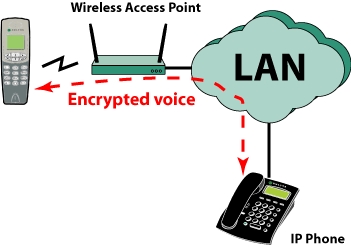Device Profile: Zultys WIP2 WiFi IP cordless phone
Aug 5, 2005 — by LinuxDevices Staff — from the LinuxDevices Archive — 84 views The Linux-powered WIP2 WiFi phone from Zultys Technologies looks, acts, and operates like a conventional cordless office telephone — but that's where the similarities end. This new VoWiFi phone is aimed at enterprises that require a user to be mobile within an office or campus but remain in contact with the corporate PBX. With its audio quality, built-in speaker phone, and support for a full set of PBX features, the WIP2 aims to replace wired desktop phones.
The Linux-powered WIP2 WiFi phone from Zultys Technologies looks, acts, and operates like a conventional cordless office telephone — but that's where the similarities end. This new VoWiFi phone is aimed at enterprises that require a user to be mobile within an office or campus but remain in contact with the corporate PBX. With its audio quality, built-in speaker phone, and support for a full set of PBX features, the WIP2 aims to replace wired desktop phones.
The WIP2 is based on open standards, Zultys says. The device uses SIP (session initiation protocol) for call control, making it compatible with any IP phone system using the SIP standards. The phone supports the 802.11b wireless standard and all applicable standards for VLANs and QoS, ensuring that it is compatible with most networks, new or old.

WIP2 system environment
The phone is easy to configure through the Outlook-like UI on the device and through a PC for the sysadmin, according to Zultys. All important settings are password-protected so changes to these settings from the phone menu can be controlled by an administrator. Firmware updates are performed using a standard USB interface on the phone.
The WIP2 also supports standard PBX features such as hold and transfer, as well as having two simultaneous call appearances that support conferencing on the phone.
Zultys is among the first wave of companies to offer cordless IP phones. Others include the Siemens OptiPoint WL2 Professional and NexGen City's NexPaq.
Key features
 Zultys lists the following key features and functions of the WIP2:
Zultys lists the following key features and functions of the WIP2:
- Supports the 802.11b WiFi standard
- Uses SIP to operate with any standard IP phone system or network
- Four-hour talk time and 12-hour standby time
- Supports all standard PBX functions
- Presence and Instant Messaging
- Two call appearances support two simultaneous calls
- Graphical backlit LCD
- Menus in multiple languages
- Speech quality ensured by QoS at the Ethernet and IP layers and comprehensive jitter buffer
- Speaker phone mode with acoustic echo cancellation for high quality audio
- Speech encryption for secure conversations
- Downloadable ring tones
- Vibrator
- Menu, browser, and TFTP support for configuration and updates
Linux inside
Zultys touts the WIP2's “highly stable embedded Linux operating system” as one of the device's selling points. The company uses MontaVista Linux as the embedded software platform in all of its IP phones, a spokesperson told LinuxDevices.com.
Other Linux-based Zultys IP phones include the Zip 4×5, an advanced IP desk-phone that integrates a VPN router, switch, firewall, and analog phone, and the ZIP 4×4, the company's first IP desk-phone. Zultys also offers a Linux-based MX1200 IP PBX, and has released a free soft-phone that runs on Linux and provides many of the features of the company's embedded-Linux-based Zip 4×4 SIP phone, without requiring a separate handset.
WIP2 feature details
A few of the more interesting capabilities of the WIP2 are described in the following paragraphs, which are based on information obtained from Zultys's website.
- Speech quality — The phone incorporates Zultys's patented jitter buffer, which ensures that speech quality is optimal, even when the network has varying delays and lost packets. This technology proves itself in a Wi-Fi environment.
- Hands-free operation — The phone allows the use of a standard USB headset. You can configure the device to behave as an intercom so that all internal or external calls are automatically answered by the speakerphone after one ring. In addition, the phone can silently disconnect at the end of a call. This permits the user to answer a call and conduct a conversation without touching the phone.
- Dialing — When using the key pad, users can dial a destination by phone number, SIP address, or IP address. Letters and special characters on the key pad operate similarly to that of the mobile phone. A SIP address can be abbreviated, for example to “sales.” The phone supports hot key dialing so that users can enter a number, IP address, or name, and review and edit the destination address prior to calling.
- Encryption — General network configuration of the WIP2 supports Wired Equivalent Privacy (WEP) encryption for securing the wireless link between the phone and the access point. In addition, the WIP2 can encrypt the voice stream to another WIP2 or other equipment that supports Advanced Encryption Standard (AES) encryption. Users can activate this function before or during a call. Alternatively, the administrator can enforce encryption so that it is not possible to establish a call without encryption.

WIP2 offers an encrypted data path - Conferencing — The WIP2 supports three-way conferencing, and individuals can join or leave the conference at any time. The conference can be put on hold, allowing the other parties to continue to talk without the host. A conference call can be entirely encrypted when all parties use phones that are capable of encryption.
- QoS support — At the IP layer, the WIP2 supports the ability to mark the lower six bits of the IP QoS byte with the various differentiated services code point (DSCP) markings. This allows for up to 64 codepoints to be defined which map to various per-hop behaviors (PHBs).
- Preferences and settings — All phone settings are accessible either from the phone or from a browser page located at the IP address assigned to the phone. There are many parameters on the phone that allow it to operate in the network.
Availability
The WIP2 will begin shipping in November 2005, according to Zultys.
This article was originally published on LinuxDevices.com and has been donated to the open source community by QuinStreet Inc. Please visit LinuxToday.com for up-to-date news and articles about Linux and open source.